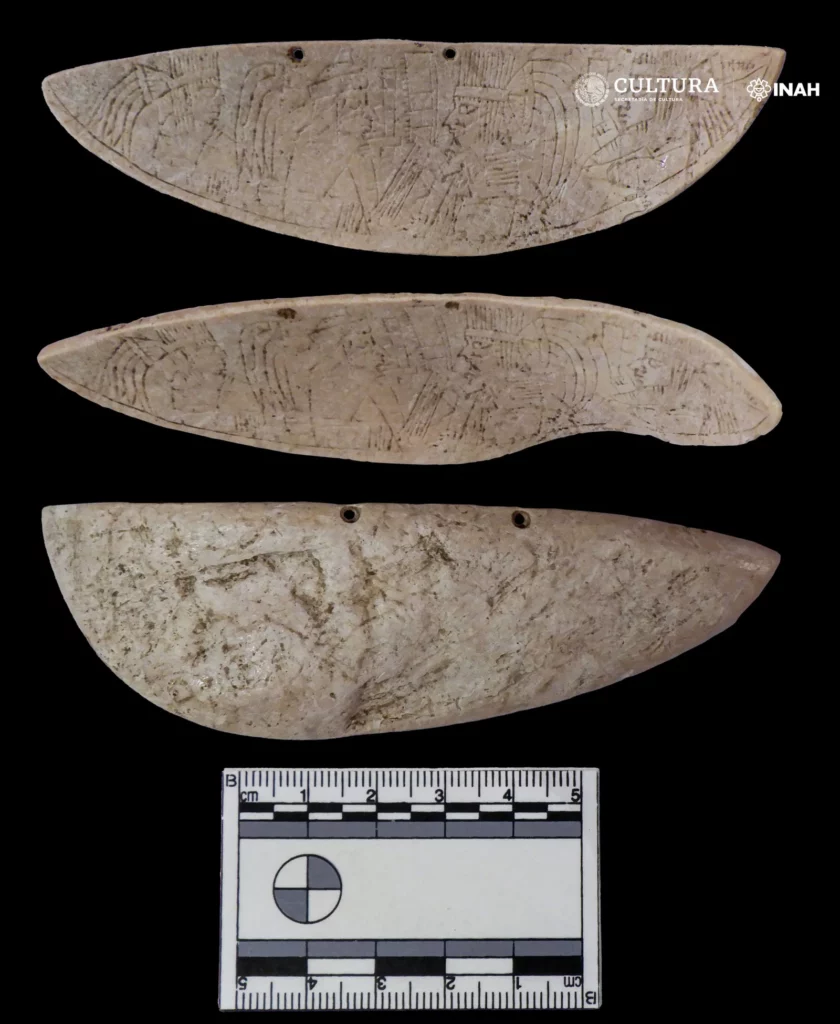On the route of the Maya Train, archaeologists have discovered a delicate choker carved in conch shell, adorned with the engraved representation of four Maya figures. Archaeologist Maricela Salazar Carrillo, who is part of the salvage project, has suggested that the choker, when related to other similar known pieces, could date to the Terminal Classic period (830-900 A.D.).
The piece, which measures 9.7 centimeters long by 2.9 centimeters wide and has a thickness of only 1 millimeter, has a semi-elliptical or crescent shape. This important discovery took place on September 13, 2023 in Nicolás Bravo, a town located in Quintana Roo, during the archaeological investigations in Section 7 of the Mayan Train route.
These artifacts are linked to diplomatic activities or the exchange of goods between ancient elites. At the time of the Maya elites, diplomacy was essential for political and social interactions. The elites, which included nobles, priests, and political leaders, employed various diplomatic strategies, such as the exchange of luxury goods, marriage alliances, the sending of ambassadors and messengers, non-aggression agreements, and the organization of diplomatic ceremonies.

In addition, diplomacy was used to resolve conflicts and disputes between Maya city-states, contributing to political stability and the maintenance of peaceful relations in a conflict-prone region. In short, diplomacy played a fundamental role in the lives of Maya elites, facilitating cooperation, trade and peace in this ancient Mesoamerican civilization. This ancient piece of ornament was discovered while removing a layer of fill located at a depth of 30 centimeters under a compacted stratum. This ancient piece of ornament was discovered while removing a layer of fill located at a depth of 30 centimeters under a compacted stratum.
The sumptuary object was elaborated on a conch shell and has been preliminarily associated to the Terminal Classic period (830-900 A.D.).
The scene carved on this pre-Hispanic choker consists of the representation of four figures in profile, each wearing a forehead band. Two of these figures look to the right, while the other two direct their gaze to the left.
“There are very few similar specimens that have been recovered or of which we are aware. Of those of which we know their provenance, we can mention a choker found in the Valley of Mexico and others recovered in contexts of the Terminal Classic period, in sites such as Ceibal, Peru-Waka’ and Uaxactun, which are located in the region of the southern Maya Lowlands.
In addition, diplomacy was used to resolve conflicts and disputes between Maya city-states, contributing to political stability and the maintenance of peaceful relations in a conflict-prone region. In short, diplomacy played a fundamental role in the lives of Maya elites, facilitating cooperation, trade and peace in this ancient Mesoamerican civilization. This ancient piece of ornament was discovered while removing a layer of fill located at a depth of 30 centimeters under a compacted stratum. This ancient piece of ornament was discovered while removing a layer of fill located at a depth of 30 centimeters under a compacted stratum.
The sumptuary object was elaborated on a conch shell and has been preliminarily associated to the Terminal Classic period (830-900 A.D.).
The scene carved on this pre-Hispanic choker consists of the representation of four figures in profile, each wearing a forehead band. Two of these figures look to the right, while the other two direct their gaze to the left.
“There are very few similar specimens that have been recovered or of which we are aware. Of those of which we know their provenance, we can mention a choker found in the Valley of Mexico and others recovered in contexts of the Terminal Classic period, in sites such as Ceibal, Peru-Waka’ and Uaxactun, which are located in the Southern Maya Lowlands region,” said archaeologist Maricela Salazar Carrillo.
Based on the context of these similar pieces, it is believed that these sumptuary objects, from the perspective of pre-Hispanic Maya art, evoke conferences or deal with themes related to diplomacy, exchange and meetings between members of ancient elites. The recently discovered choker is being guarded by INAH and will continue under study, due to its quality, its future exhibition is planned in a venue yet to be defined.
The political organization in the Postclassic period in the Maya area was distinguished by its diversity, manifesting itself in three distinct forms. In the first place, a decentralized structure is observed, where independent communities exercised their own government, according to the records of the Maya-Itzaes.
Secondly, a system of co-government is identified, in which two leaders or sovereigns shared power. The names of these leaders were Ahpozotzil and Ahpoxahil.
The third form of organization was centralized in nature, with a principal leader in command of a specific territory, as evidenced in Yucatán. This top political figure was known as the “halach uinic”, and his responsibilities were not limited to the political realm alone, but also encompassed judicial, military and religious matters. The halach uinic resided in the capital and had authority over the various caciques or “bataboob”, who played a crucial role as the main political authorities of the various communities and towns that made up the territory.
TYT Newsroom


